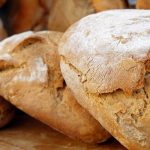✅ Glucono-Delta-Lactone (GDL) is a naturally occurring acidic compound derived from gluconic acid, which is found in fermented foods, honey, and fruits. It is not an acid itself but as a solid, an inner-ester of gluconic acid.
✅ It is a mild, slow-acting agent that hydrolyzes into gluconic acid becoming an acid when mixed with water.
✅ Commonly used in food processing as a leavening acid, pH regulator, and coagulant.
✅ EU food additive code: E575
✅ Chemical formula: C₆H₁₀O₆
How Does GDL Work as a Leavening Agent?
-
GDL acts as a slow-release acid, making it ideal for controlled leavening reactions especially biscuits (Sykes & Davidson, 2020). At ambient temperatures this hydrolysis takes about 2 hours where it yields 55 to 60% gluconic acid. Higher temperatures produce faster hydrolysis times.
-
When mixed with baking soda (sodium bicarbonate, E500), it gradually lowers the pH, allowing CO₂ gas to be released at a steady rate.
-
Unlike fast-acting acids (e.g., cream of tartar or vinegar), GDL gives a more controlled rise, making it useful in baked goods that need longer resting or proofing times. It is ideal in dry mixes and can be coated to reduce moisture transfer and so reduce the hydrolysis time.
💡 Reaction Process
-
GDL dissolves in water, slowly converting to gluconic acid.
-
Gluconic acid reacts with baking soda, producing carbon dioxide (CO₂).
-
The CO₂ expands in the dough/batter, causing it to rise.
-
The slow reaction prevents over-expansion or collapse, ensuring a more uniform texture.
Benefits of GDL in Baking
✅ Aluminium-Free Alternative – No need for aluminium-based acids like sodium aluminium phosphate (SAP) or sodium aluminium sulfate.
✅ Controlled Leavening – Provides a gradual, steady rise, ideal for crackers, cookies, and pancakes.
✅ Neutral Taste – Unlike vinegar or citrus acids, GDL has a mild, slightly sweet flavor, preventing an overly acidic taste.
✅ Works in Low-Moisture Doughs – Unlike fast-reacting acids, GDL works even in dry cracker doughs.
✅ Dual-Function in Dairy & Tofu – It is also used as a coagulant in tofu-making and pH adjuster in dairy products.
How GDL is Used in Baked Goods
| Product | Why Use GDL? | Typical Ratio (per 1 tsp baking soda) |
|---|---|---|
| Crackers & Biscuits | Provides slow, even leavening for thin, crispy texture. | ½ to 1 tsp GDL |
| Cookies | Reduces spread, helping maintain shape. | ½ tsp GDL |
| Pancakes & Waffles | Helps consistent rise without over-expansion. | 1 tsp GDL |
| Gluten-Free Baked Goods | Aids leavening without gluten development issues. | 1–1.5 tsp GDL |
| Cakes & Muffins | Provides a more controlled rise than fast-acting acids. | 1 tsp GDL |
💡 Usage Tip:
-
Since GDL is a slow-acting acid, it works best in recipes where dough/batter rests before baking (e.g., crackers, cookies, slow-rising baked goods).
-
It is commonly combined with baking soda (NaHCO₃) in a 1:1 or 2:1 ratio, depending on the recipe. The alkaline sodium bicarbonate is added in excess and has a slight alkalizing effect.
Comparison of GDL vs. Other Leavening Acids
| Leavening Acid | Reaction Speed | Best For | Aluminium-Free? |
|---|---|---|---|
| GDL (E575) | Slow & controlled | Crackers, cookies, pancakes | ✅ Yes |
| Cream of Tartar (E336) | Fast | Cakes, meringues | ✅ Yes |
| Vinegar / Lemon Juice | Very fast | Quick breads | ✅ Yes |
| Monocalcium Phosphate (MCP, E341i) | Fast & moderate | Baking powder, muffins | ✅ Yes |
| Sodium Aluminium Phosphate (SAP, E541) | Moderate to slow | Self-rising flour, baking powder | ❌ No |
Final Thoughts
-
GDL is an excellent aluminium-free leavening agent, especially for crackers, cookies, and gluten-free baked goods.
-
It provides a slow, steady rise, making it different from fast-reacting acids like vinegar or cream of tartar.
-
Works well in low-moisture and resting doughs, where other acids may react too quickly.
References
Sykes, G.B., Davidson, I. (2020) Biscuit, Cookie and Cracker Process and Recipes Chapt 5. pp.143 .

Leave a Reply